Fontana Lake is ideal for those seeking an exciting fishing experience in the Great Smoky Mountains. This captivating waterbody covers two counties, Graham and Swain, attracting visitors with its charm and thriving ecosystem.
Scores of tourists rush to this haven, enticed by the abundant gamefish awaiting capture, whether from the shoreline or aboard a boat. With its impressive depths and captivating beauty, Fontana Lake is a haven for anyone seeking adventure and tranquility on the water.
In this blog post, we shall delve into the information about Fontana Lake, along with handy techniques and strategies for fishing in this breathtaking aquatic expanse.
Fontana Lake Profile
| Location | Graham and Swain Counties, NC |
| Length | 17 miles (27 kilometers) |
| Width | Varies based on the shape |
| Surface Elevation | 1,703 feet (519 meters) |
| Average Depth | 135 feet (41 meters) |
| Deepest Point | 440 feet (130 meters) (the deepest lake in NC) |
| Shoreline | Approximately 238 miles (383 kilometers) |
| Primary Inflows | Little Tennessee River and Nantahala River |
| Primary Outflows | Little Tennessee River |
| Surface Area | 10,230 acres |
History and Construction of Fontana Lake
The Tennessee Valley Authority (TVA) constructed the Fontana Dam, giving rise to Fontana Lake. The dam aimed to fulfill two purposes — power production for the nearby Oak Ridge Nuclear Facility and control of periodic floods along the broader reaches of the Tennessee River valley. Starting in November 1944, the gradual filling of Fontana Lake flooded nearby towns such as Proctor, Almond, Japan, and Forney.
Construction of the dam took three years to complete, beginning in January 1942, and ultimately cost $74.7 million. The dam’s construction used approximately 2.8 million cubic yards of concrete and involved roughly 34.5 million man-hours.
The hydroelectric potential provided by the dam resulted in a total generating capacity of 225,000 kilowatts spread across three generators. The famous Appalachian trail traverses the entire dam length, creating beautiful vistas and outdoor adventures for visitors and hikers alike.
The Fontana Dam remains one of the most impressive man-made structures on the East Coast. Visitors flock here to participate in aquatic sports like boating and fishing in the spring, fall, summer, and winter.
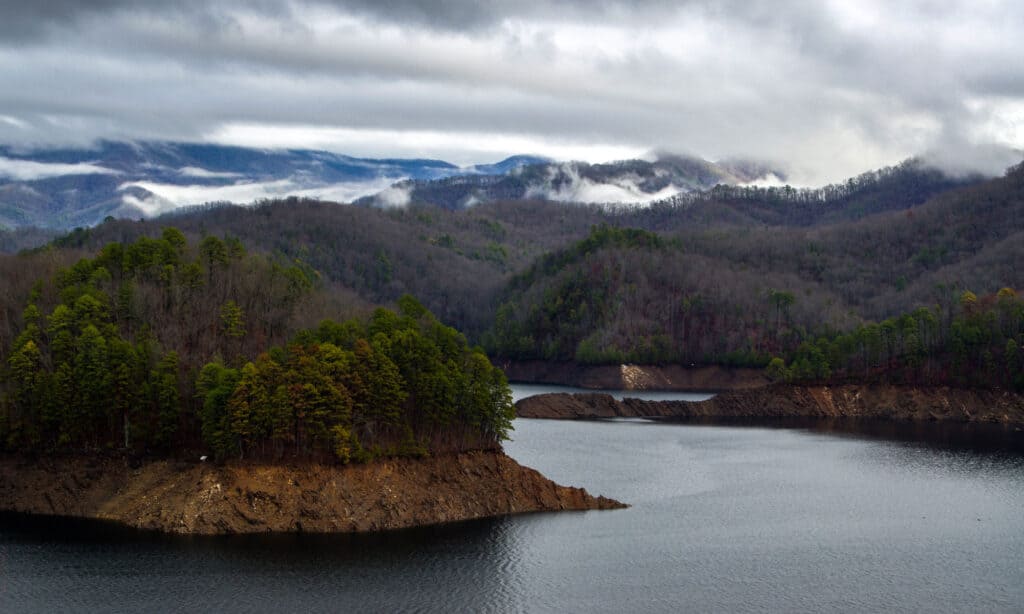
The creation of Fontana Dam served as the catalyst for Fontana Lake.
©iStock.com/Joshua Moore
Size and Depth
Fontana Lake sits at a relatively high altitude with a surface elevation of 1,703 feet. Despite its relatively short length of 17 miles, Fontana Lake stands apart with its maximum depth of 440 feet, securing its position as North Carolina’s deepest lake. The irregular coastline spans approximately 238 miles. Its surface area is about 10,230 acres.
Fish Species and Fishing on Fontana Lake
Largemouth Bass (Micropterus salmoides)
Fontana Lake boasts a fantastic array of fish, but the true standout among them is the largemouth bass. These powerful creatures have a knack for packing on the pounds, some surpassing the 20-pound mark. Once hooked, they proudly exhibit their strength, delivering forceful strikes and breathtaking leaps that never fail to captivate.
Largemouth bass inhabit various hiding spots throughout the lake, concealing themselves amidst dense vegetation, nesting in rocky enclaves, or lurking near submerged trees. They are not picky when it comes to their diet. From shad and bluegills to crawdads and minnows, they devour almost anything that comes their way.
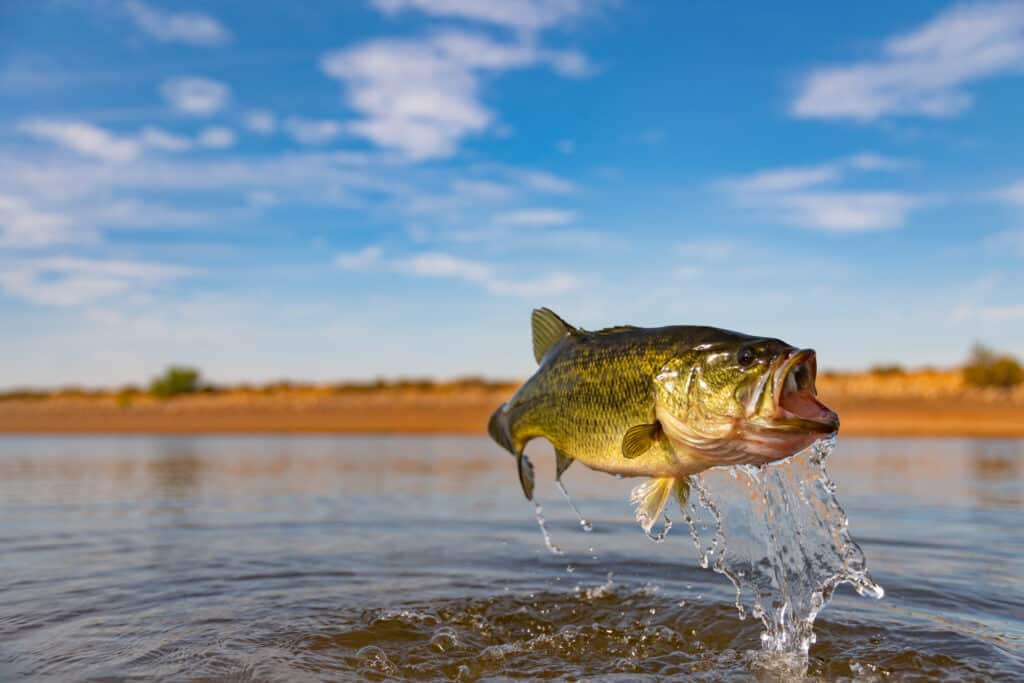
The impressive largemouth bass reigns supreme at Lake Fontana.
©Ryno Botha/Shutterstock.com
How to Catch Largemouth Bass on Fontana Lake
Largemouth bass thrive in Fontana Lake throughout the year, with their activity peaking during the spring and fall seasons as they migrate toward shallower waters for spawning or feeding.
This increased activity presents a prime opportunity for anglers to locate and target them. Catching bass on Fontana Lake can be accomplished through various methods, depending on weather conditions and personal preference. Here are some of the most effective ones:
- Ned Rigs: The Ned rig consists of a light jig head with a small plastic worm or stick bait. Its purpose is to imitate a distressed baitfish, delicately descending to the bottom and enticingly wiggling into an upright position. You can allow it to sink to the depths gracefully by casting it close to bass-harboring cover or structures. Subsequently, a gentle twitch or a leisurely drag along the bottom adds to its allure. The Ned rig proves particularly effective when the water is clear and cold or when the bass is under pressure or in a picky mood.
- Crankbaits: A crankbait is a hard plastic lure with a lip that makes it dive and wobble when retrieved. Crankbaits are great for covering water and triggering reaction bites from a bass. Depending on the water’s clarity, temperature, and depth, you can choose different crankbait sizes, colors, and depths. You can cast them parallel to the shoreline or along points and ledges where the bass feeds or basks. You can vary your retrieve speed and direction to make them more erratic and enticing.
- Topwater Lures: A topwater lure actively makes a splash and attracts bass with its enticing noises. These lures provide a visual spectacle and allow you to hear the exhilarating moment when a bass strikes. They work wonders during low-light periods like early mornings or late evenings and when there’s a gentle breeze or cloudy skies. You can try various topwater lures, such as poppers, walkers, buzz baits, frogs, or prop baits.
Rainbow Trout (Oncorhynchus mykiss)
When it comes to freshwater angling, few species can rival the excitement brought by the pursuit of rainbow trout. These fish species are prized among fishermen across North America due to their incredible strength, ability to leap out of the water in acrobat fashion, and mouthwateringly succulent meat. And in lakes like Fontana, the potential size of these fish truly astounds!
Rainbows thrive in various environments, not just cold alpine waters. They’ve demonstrated adaptability in scorching hot springs and icy rivers cascading down mountainsides.
The lake’s considerable depth, refreshingly cold temperature, and abundant oxygen supply have contributed to the sustained growth of rainbow trout year after year. Anglers have reported higher success rates when fishing closer to the dam area, where the depth remains consistent, the environment stable, and temperatures favorable. These factors work in perfect harmony, ensuring that rainbow trout return to Fontana Lake repeatedly.
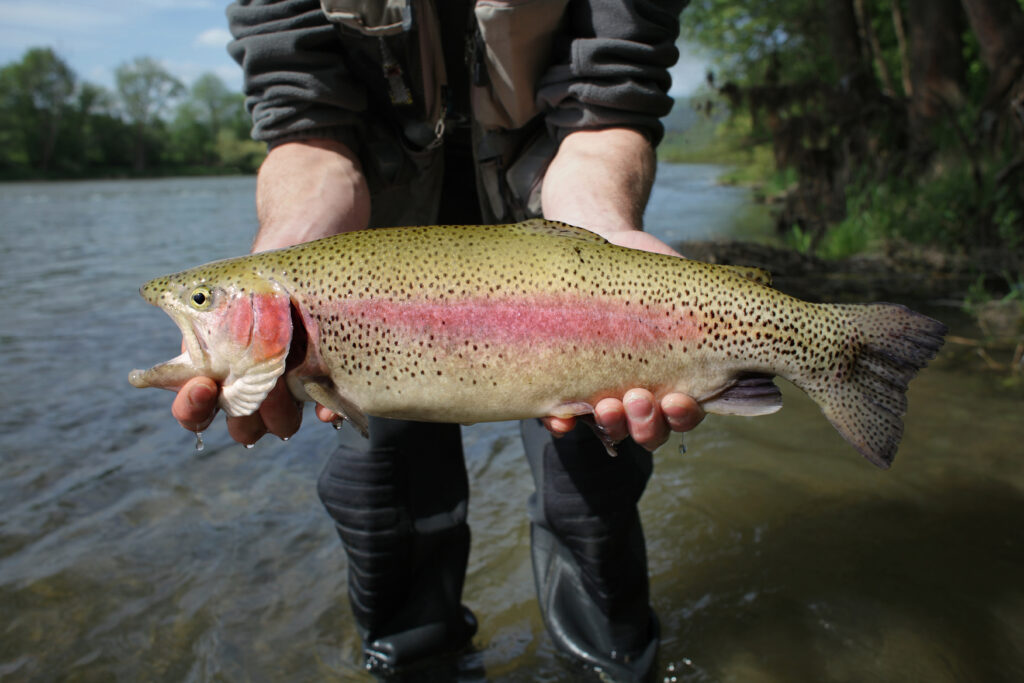
The potential size of rainbow trout caught at Lake Fontana is astounding.
©pictoplay/Shutterstock.com
How to Catch Rainbow Trout on Fontana Lake
Here are some techniques for targeting rainbow trout at Fontana Lake, suitable for anglers of all skill levels:
- Live bait: Use minnows, worms, corn, cheese, or even salmon eggs as enticing options. Pay attention to the different temperature zones in the water (known as thermoclines) and adjust your bait’s depth accordingly, whether it stays near the bottom or hovers just above the temperature change.
- Artificial baits: Rainbow trout are known to be receptive to artificial baits. Consider using spoons, spinners, jiggers, cranks, or soft plastic lures that resemble their natural food. When fishing downstream or in still waters, opt for slow retrieves. On the other hand, faster retrieval works better when fishing upstream. Remember that the time of year and the fish’s behavior affect their preferences. If they initially show disinterest, try changing your tactics by altering the speed and adding twitching motions.
- Fly fishing: Another option worth considering is using fly fishing techniques. Dry flies, wet flies, or underwater insect imitations can all be effective. Cast your line from the shore or while boating (using sinking or floating lines). You can achieve results by stripping the line, creating gentle sideways motions, or simply allowing the fly to descend naturally until the right moment strikes.
Yellow Perch (Perca flavescens)
Yellow perch, closely related to walleye and sauger, are vibrant freshwater fish known for their beautiful colors and patterns. Their bodies showcase a blend of gold, green, and black hues. These adaptable creatures thrive in various habitats and have a diverse diet, feeding on multiple organisms. Fontana Lake offers multiple zones where yellow perch can be found, influenced by seasonal changes and water flow from nearby sources.
These fish migrate to shallower areas near the shores and flatlands in autumn. This presents an excellent opportunity for anglers to catch them using lightweight jigs, spinners, and small lures. Natural baits or live trailers also work well during this time.
In winter, yellow perch move to deeper waters, forming large clusters beneath the surface. Fishing for them requires a strategic approach and delicate ice fishing equipment such as small jigs, lures, or live bait.
As spring arrives, these fish gather in shallow sections near vegetation and rocks for spawning. Anglers can take advantage of their increased hunger and eagerness to bite by using various bait options, including crankbaits, topwater baits, and live baits.
During summer, yellow perch become harder to locate. Water conditions influence their depth preferences. Anglers may need to rely on sonar devices to find them and should vary their selection of lures and baits accordingly.
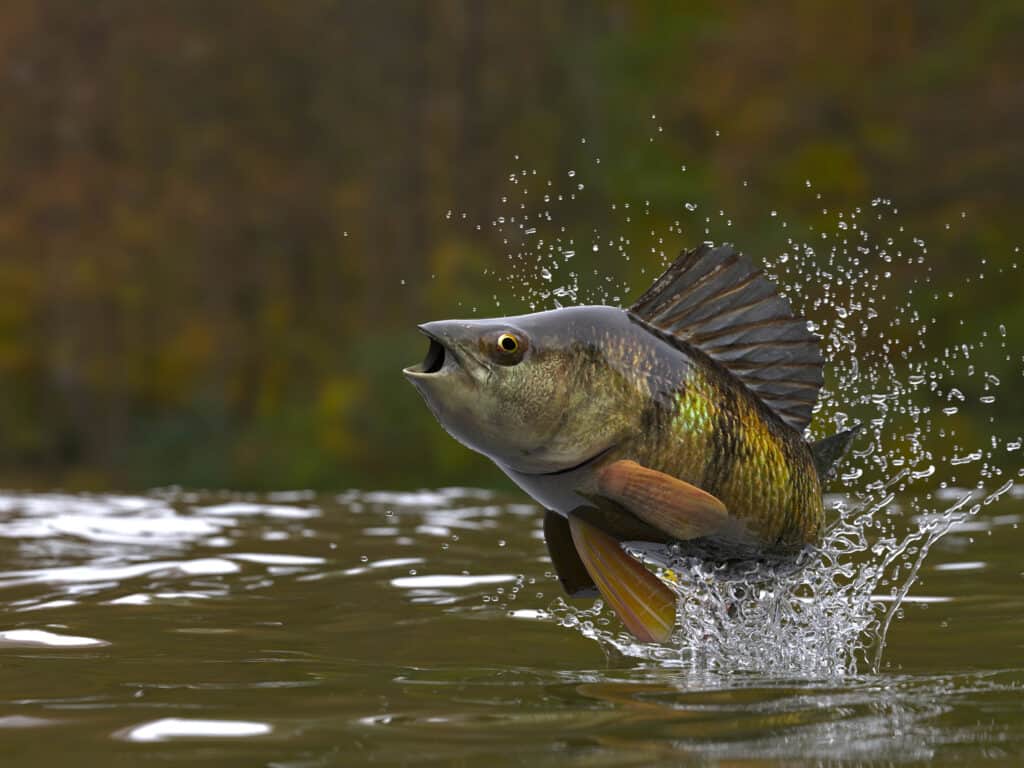
Thriving in diverse habitats, these adaptable fish offer a captivating sight with their gold, green, and black tones.
©bekirevren/Shutterstock.com
How to Catch Yellow Perch on Fontana Lake
Try these practical techniques to catch yellow perch on Fontana Lake successfully:
- Drift with Precision: Drifting is a fantastic method for covering a large area of water while actively seeking out schools of yellow perch. Equip yourself with a slip bobber or a bottom bouncer rig and entice these fish using live baits like minnows, worms, or maggots. Enhance your presentation by adding attractors such as spoons or spinners to grab the attention of the yellow perch.
- Master the Vertical Jig: If you’re targeting deeper waters, especially with specialized rods designed for ice fishing or jigging, vertical jigging is the way to go. Trail a minnow, worm, or maggot with a small jig or employ a drop shot rig to entice yellow perch successfully.
- Explore the Art of Casting: Casting is a delightful technique for anglers who want to focus on shallow waters or areas with abundant cover. Arm yourself with a spinning rod or bait caster loaded with light lines and opt for small offerings like crankbaits, jerk baits, spinnerbaits, or jigs, combined with live baits. Fly fishing enthusiasts can also experiment with small streamers or nymph flies, casting them around rocks, vegetation, and other potential hiding spots for yellow perch.
Crappies (Pomoxis)
Crappies belong to the sunfish family. These freshwater fish come in different varieties, namely, black and white crappies. Both can be found in Fontana Lake, with white ones having a higher prevalence. Interestingly, these fish swim together in large groups, making them ideal targets for anglers who enjoy sport fishing. However, the majority are less than half this length due to their size constraints (usually measuring around 10 inches long). Furthermore, the preferred temperature range for crappies is between 65 °F to 75 °F, so the deep waters near the center of lakes appeal to them during autumn.
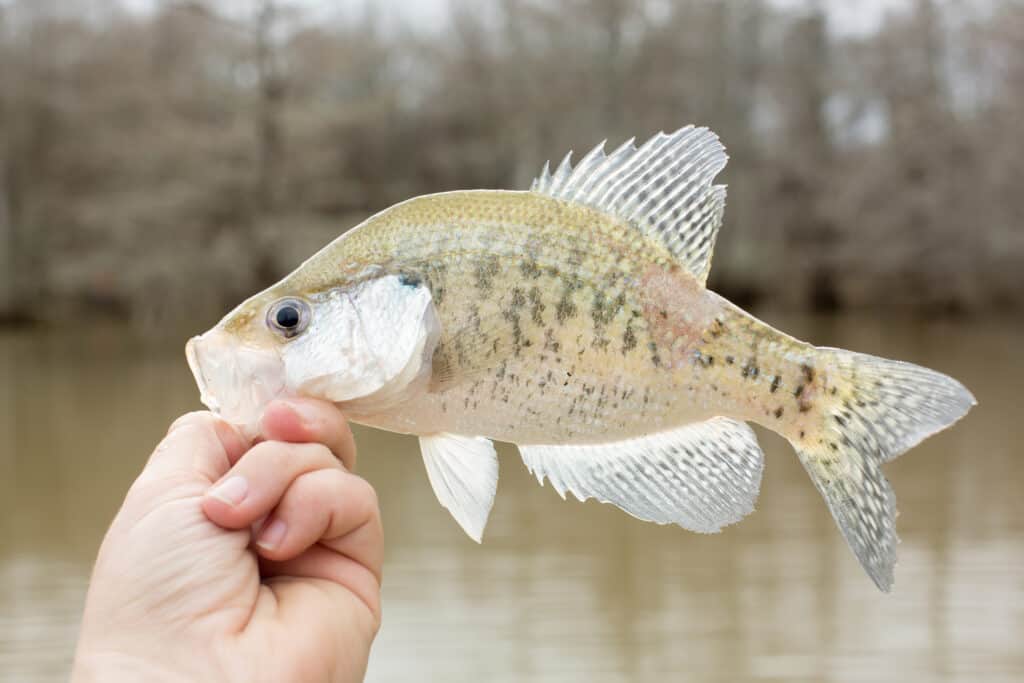
White crappies are more prevalent compared to their black counterparts at Fontana Lake.
©Jennifer White Maxwell/Shutterstock.com
How to Catch Crappies on Fontana Lake
If you fancy trying your hand at crappie fishing in Fontana Lake, here are some helpful tips and tricks:
- Tackling: Use lightweight to moderate spinning gear combined with lines ranging from 4 to 8 pounds in strength.
- Attractants: Opt for vividly colored jigging equipment or live bait to draw attention in transparent bodies of water.
- Locating fish: Take advantage of your trusty fishfinders or sonars to detect concentrations of crappie along with their favorite hiding places.
- Perseverance is key: Don’t become discouraged if initial attempts prove unsuccessful; modify depth, speed, or position to uncover where the crappie is biting.
- Conservation first: Be mindful of preserving this prized game fish by practicing catch-and-release strategies. Remember to think ahead to ensure their continued existence for years to come.
Bluegill (Lepomis macrochirus)
Fontana Lake’s ecosystem is dominated by bluegills, which are abundant and easy to find. They live in various habitats: plants, piers, submerged timbers, rocks, and different water depths. These adaptable fish eat a variety of organisms, including bugs, earthworms, shrimp, smaller fish, and more, making them easy to catch.
How to Catch Bluegills on Fontana Lake
To catch bluegills, use mild equipment and small baits that appeal to their appetites. A traditional setup with bobbers and mealworms is effective as are tiny lures like small jigs, spinners, spoons, or flies. Pay attention to the structure of the water and the lower sections, as these are popular areas for the fish to gather.
Bluegills thrive in warmer seasons when they are mating. They come closer to the shore to establish their nests and continue their legacy. In other words, anglers can enjoy high levels of exciting fishing during these peak periods of breeding activity.
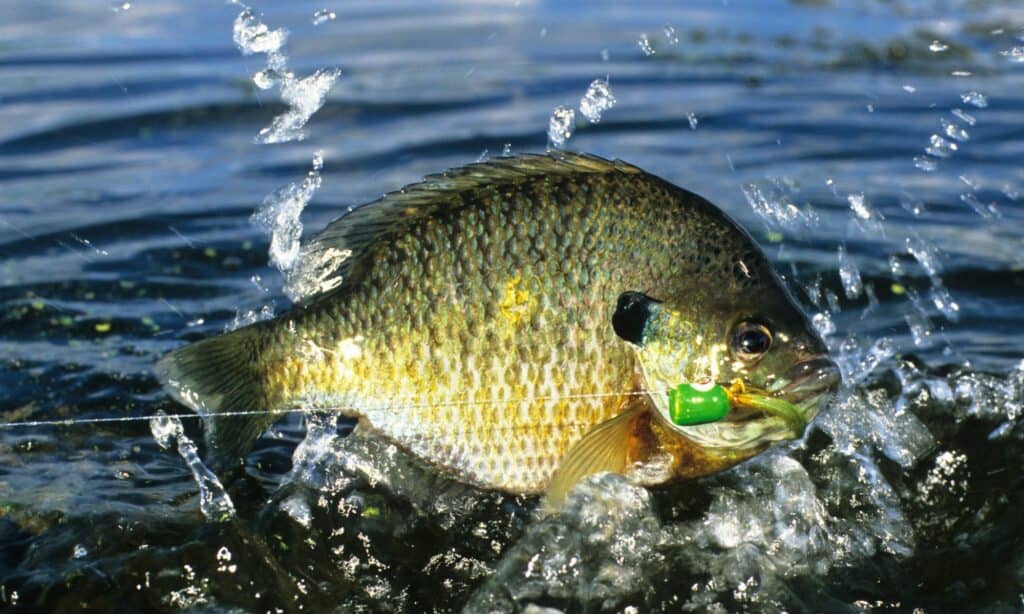
To catch bluegills, use mild equipment and small baits that appeal to their appetites.
©iStock.com/stammphoto
Muskie (Esox masquinongy)
Fontana Lake is home to a fearsome predator called the muskellunge. These enormous creatures can grow to over 70 inches in length and weigh up to 70 pounds, making them a source of great excitement for anglers throughout North America. However, these impressive fish don’t just sit around waiting to be caught. It takes skill and a lot of work to reel in this fascinating species.
The presence of muskie can be experienced throughout the year in Fontana Lake, although specific periods offer better accessibility. In the scorching summer months, they seek out cool depths; in colder weather, they return to shallower areas. As darkness descends and night takes over, their hunting instincts intensify, making for prime fishing around dawn and dusk. For the ultimate adrenaline rush, focus your fishing efforts from autumn to winter.
How to Catch Muskies on Fontana Lake
Heavy tackle required
- 7-9 feet medium-heavy or heavy action rod
- Baitcasting reel
- Braided line (50-80 pounds)
- Steel/fluoro carbon leader (at least 12 inches)
Right Lure Matters
- Bucktails, jerk baits, crankbaits, swim baits and top water lures preferred
- Suckers or shiners are sometimes used (make sure they are legal)
Vary Retrieval Technique
- Try fast and erratic vs. slow & steady
- Pause, twitch and change direction
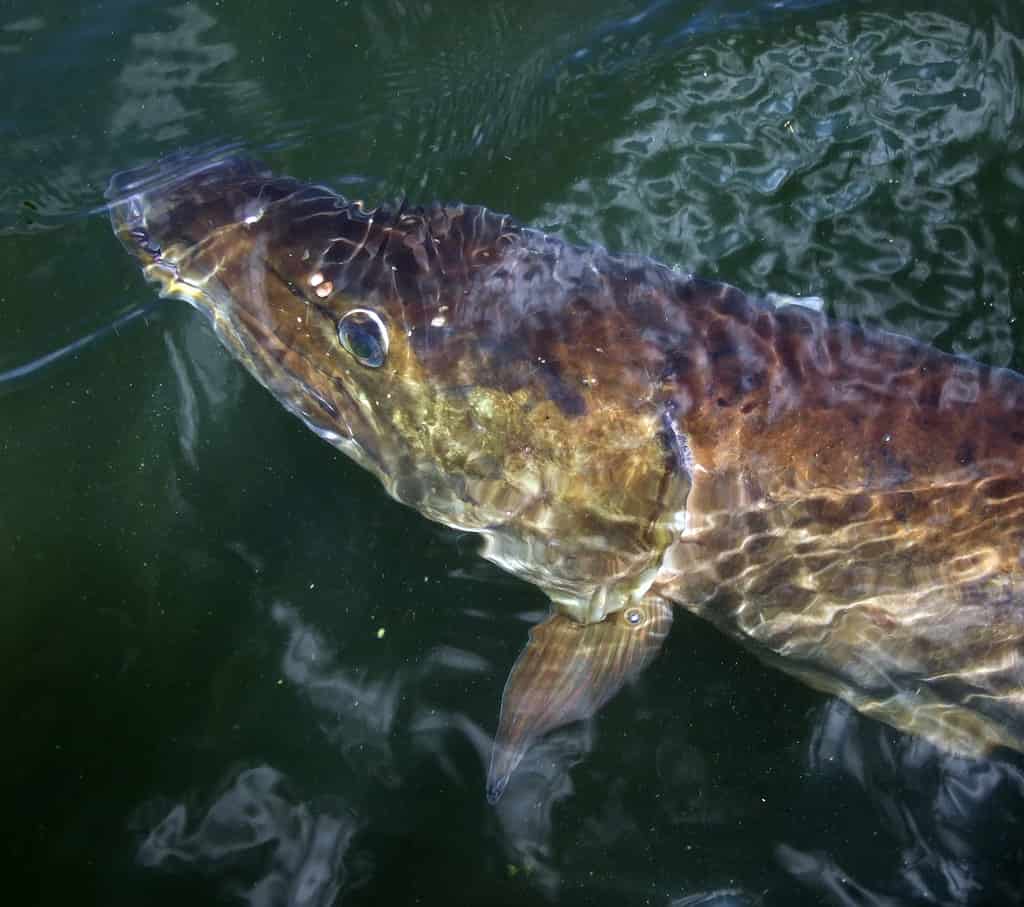
A muskie can grow to over 70 inches in length and weigh up to 70 pounds.
©M Huston/Shutterstock.com
Angling Thrills, Size, Depth, and Beyond
Fontana Lake in North Carolina offers a captivating fishing experience with its diverse fish species and impressive size and depth. Created by the Fontana Dam, the lake serves multiple purposes, including power production and flood control. With a length of 17 miles and a maximum depth of 440 feet, Fontana Lake stands as the deepest natural freshwater body in North Carolina. The lake’s irregular coastline spans approximately 238 miles, providing numerous geological formations shaped by water movements and weather conditions.
Largemouth bass, rainbow trout, yellow perch, crappies, bluegills, and muskies are among the abundant gamefish in the lake. Anglers can employ various techniques and strategies, such as using Ned rigs, crankbaits, topwater lures, live bait, or artificial baits, to target specific fish species.
The photo featured at the top of this post is © Ilir Hasa/Shutterstock.com
Thank you for reading! Have some feedback for us? Contact the AZ Animals editorial team.







